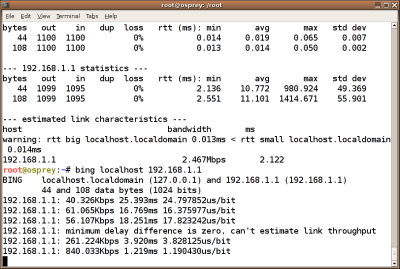Main / GroupTwoLinkImp
LONG DISTANCE LINK IMPLEMENTATION
The link between our client and the access point was tested sucessfully in the more controlled lab environment the night before.
The groups met at 8:30am, picked up all needed accessories/equipments from the Laboratory in Galileo Building. The items used at the site in San Giusto are:
- Power supply, Solar panel, Inverter, Batteries and Cables.
- Wifi stuff...
- Two portable Spectrum Analyzers for channel monitoring and signal strength measurement.
- Antenna (Cantenna etc...).
- Antenna mast and accessories.
- Flushed Linksys WRT 54 GL Wireless-G Broadband Router.
- Tools (i.e. pliers, screwdrivers, spirit level, etc), RF cables, UTP cables and adaptors.
- Laptops with Netstumbler, KISMET and Radiomobile installed.
- GPS, compass, map, ruler...
Arrived in San Giusto at 9:30am and setup the antenna mast...
We first mounted the omnidirectional antenna (i.e. HyperLink Technologies Model HGV-2410U, Freq 2400-2500 Megahertz, Gain 10dBi), connected it to the spectrum analyzer and tried to pick up a signal at 2.4Gigahertz, sent from the mast at the Galileo Building (just over 7 km path length). Unfortunately the link couldn't be established with the omni. Possible reasons for this could be
- Cabling problems.
- Low antenna gain
- Interference
Subsequently, we mounted a directional antenna (Conifer II T2127 24dBi Grid). In this case, we had to use a compass to confirm the azimuth of the link. The antenna was then aligned in the direction of the link whilst using the spectrum analyzer to ascertain the signal strength. The link was established successfully in this case. However, the received signal was very weak due to interference on channel 11 from many nearby access points. To alleviate this noise problem, the transmitting station was radioed to change the channel to 4. At this channel a signal with reduced noise was received.
Next, we connected the Wireless-G Broadband Router (configured as a client with dd-wrt) and could see the Galileo Guest House Access point with signal level -87db and noise -92db.


This bad SNR (signal-to-noise-ratio) subsequently improved when we switched channels.
The link came up and pinged at 2ms round-trip and bing estimated the throughput at 2.3Mbps.

Bing reported a lower estimated throughput while Rob was video-chatting with the home base.

Finally, one Cantenna was tested and the link was successfully established.
